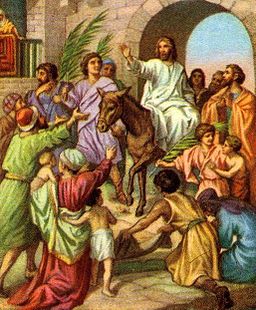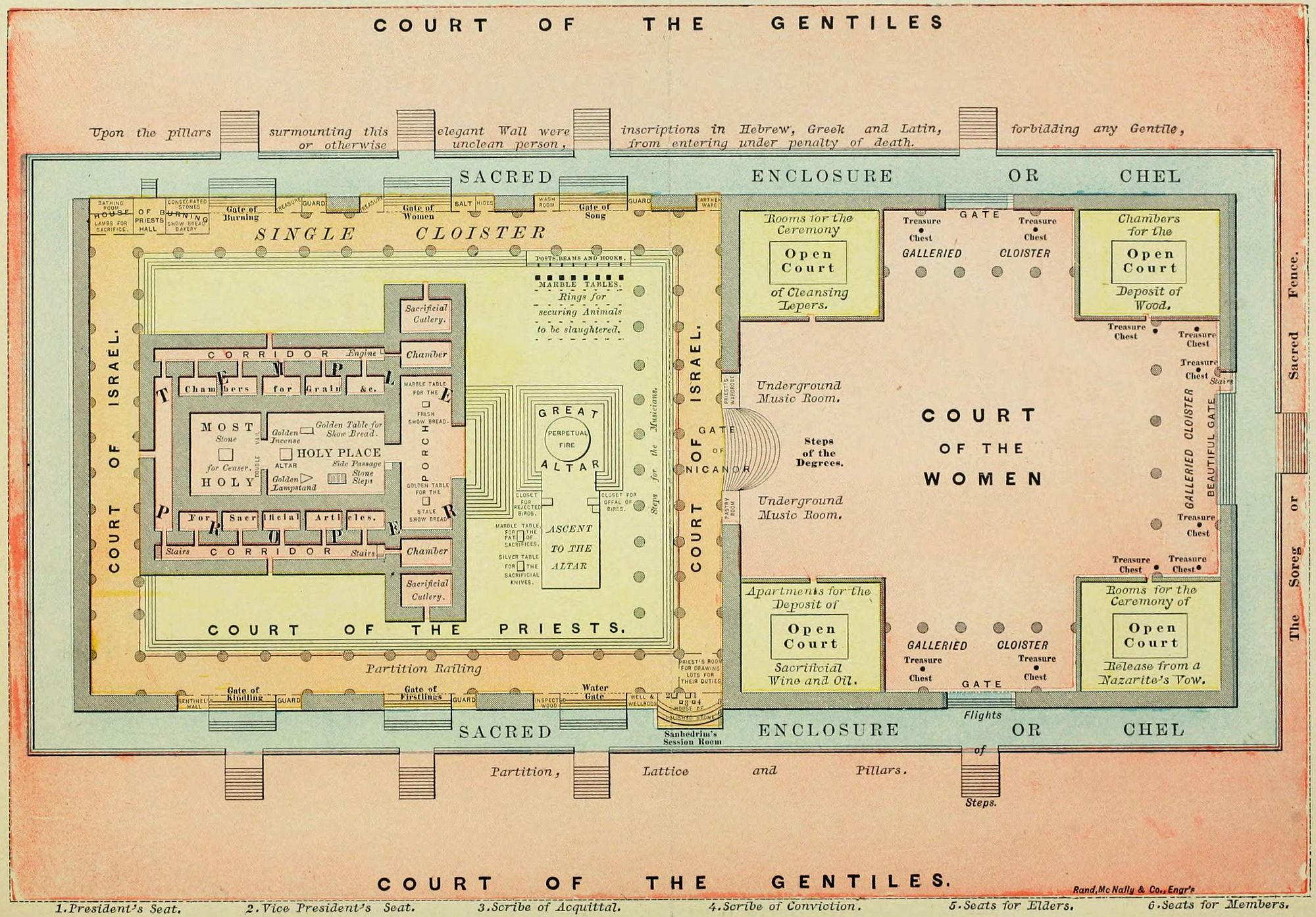 |
| By Unknown publisher of Bible Card (http://thebiblerevival.com/clipart46.htm) [Public domain], via Wikimedia Commons |
BACKGROUND
Palm Sunday, Spring A.D. 30
183. Jesus Rides into Jerusalem on a Donkey: Matthew 21:1-11, Mark 11:1-11, Luke 19:28-44, John 12:12-19
Jesus is riding on to die. This is the start of the final days of Jesus' life. Jesus' death is emphasized in all four gospels. Matthew devotes 33 percent, Mark 37 percent, Luke 25 percent, and John 42 percent to the last seven days of Jesus' life.
This event is often called the "Triumphal Entry." Jesus entered Jerusalem for the last time and the mood was celebratory for some but others plotted His death.
Jesus rode on a donkey as a just and humble King and fulfilled the prophecy found in Zechariah 9:9, but He also rode on to die. All four Gospel accounts include this event, but Matthew 21:2 mentions a donkey and a colt. Mark 11:2 and Luke 19:30 record the colt only. A simple explanation would be that a mother donkey would naturally go along with her colt. Apparently, Jesus rode on the colt so Mark and Luke did not add that his mother came along. Also, Matthew would often add more detail for his Jewish audience. John starts his narrative when Jesus enters Jerusalem and mentions nothing about the donkey or the colt.
The crowd spread out palm branches. The palm symbolized the beauty and righteousness of man (Psalm 92:12-14). It also symbolized the head of state and victory. "Hosanna!" means "save now" in Hebrew, and they were asking the One who was coming in the "name of the Lord" (Psalm 118:25-26) to do just that!
When Jesus rides in, the crowd acknowledges Him as the Son of David, the Messiah they have waited for all these years. There are three different groups present:
1) Passover pilgrims (John 12:12,18)
2) Locals who had witnessed the raising of Lazarus (John 12:17)
3) Religious leaders who threatened He would start a revolution (John 12:19)
The religious leaders were threatened because Jesus' followers were proclaiming Him to be the Messiah or King and because Jesus prophesied that Jerusalem would someday fall (Luke 19:39-44). It did just that when the Romans totally destroyed it in A.D. 70. National acceptance of Him would have brought them peace, but they did not recognize the time of God's coming! So sad!
184. Jesus clears the temple again: Matthew 21:12-17, Mark 11:12-19, Luke 19:45-48
The Matthew account implies that Jesus entered the temple after His triumphal entry into Jerusalem (Matthew did not write chronologically), but the other accounts indicate He went out to spend Sunday night in Bethany and came back to the temple the next morning (Mark 11:11-16).
On his way to the temple, the Matthew and Mark accounts record Jesus cursing a fig tree. Many commentators believe this was an "acted out parable" of the clearing of the temple. The fig tree had the potential for fruit, but it did not produce anything; just as the temple did not reach its potential for being a "house of prayer for all nations." This was figuratively a rejection of the nation of Israel and the prediction that they would wither away. This came true. In 70 AD, the nation of Israel ended when the Romans came and demolished the temple.
This is the second time Jesus has cleared the temple. The first one was recorded in John 2:13-25 (Event #23). He cleared the Court of the Gentiles (on the outside in the diagram).
 |
| www.donweaver.org |
In the Court of the Gentiles, there was buying and selling of animals for the many pilgrims who were required to come to Jerusalem for the Passover and make sacrifices for sins. Merchants and money changers were allowed there making it crowded and difficult for worship.
The city itself and the neighbourhood became more and more crowded as the feast approached, the narrow streets and dark arched bazaars showing the same throng of men of all nations as when Jesus had first visited Jerusalem as a boy. Even the temple offered a strange sight at this season, for in parts of the outer courts a wide space was covered with pens for sheep, goats, and cattle to be used for offerings. Sellers shouted the merits of their beasts, sheep bleated, oxen lowed. Sellers of doves also had a place set apart for them. Potters offered a choice from huge stacks of clay dishes and ovens for roasting and eating the Passover lamb. Booths for wine, oil, salt, and all else needed for sacrifices invited customers. Persons going to and from the city shortened their journey by crossing the temple grounds, often carrying burdens … Stalls to change foreign money into the shekel of the temple, which alone could be paid to the priests, were numerous, the whole confusion making the sanctuary like a noisy market. (Geikie’s Life of Christ from Easton’s Bible Dictionary)
In addition, the money changers would often charge exorbitant exchange rates for the foreign worshipers and the merchants would jack up the prices. This angered Jesus because greed flourished rather than worship.
Jesus condemned them for the corruption of their worship without true devotion to God. They had made this "house of prayer for all the nations" a "robber's den [cave]" (Mark 11:17, Isaiah 56:7; Jeremiah 7:11).
The Mark and Luke accounts record that this caused the religious leaders to seek a way to destroy Him because the multitudes were hanging on His every word. Luke's account mentions that Jesus was "everyday teaching in the temple" (Luke 18:47).
188. Jesus says the disciples can pray for anything: Matthew 21:18-22, Mark 11:20-26
The Matthew account summarizes the whole incident with the fig tree even though He passed by and cursed the fig tree on the way to the temple (Event #184, Matthew 21:18-19a, Mark 11:12-14), and they noticed it withered on His way back to Bethany from Jerusalem (Matthew 21:19b-22, Mark 11:20-26). He cursed it to figuratively reject Israel (Jeremiah 8:13; Hosea 9:10, 16; Luke 13:6-9), but He also used it as an object lesson about faith and prayer. We can pray and believe, in faith, that God will answer those prayers that are according to His will and for His glory!
189. Religious leaders challenge Jesus' authority: Matthew 21:23-27, Mark 11:27-33, Luke 20:1-8
This event and the three parables following it (Mark and Luke only record one of them) stem from the religious leaders questioning Jesus about what authority He had to do "these things" (probably meaning purging the temple the previous day, miracles, healing, deliverance, and teaching that proved His authority). Jesus was not trying to avoid the issue by taking them all the way back to John's ministry but was using a common debating approach with Rabbis.
John was sent by God and prepared the way for Jesus, but they rejected John (Herod had him beheaded). Therefore, they could not accept John's authority but rejected him. If they did this to John, they had done it to Jesus. If they rejected John's teaching, they would not understand Jesus' answer as to what authority He had cleansed the temple.
Worship and thank God through the Psalm that is quoted in Mark 11!
PRAYER
Blessed is the one who comes in the name of the Lord;
We have blessed you from the house of the Lord.
The Lord is God, and He has given us light;
Bind the festival sacrifice with cords to the horns of the altar.
You are my God, and I give thanks to You;
You are my God, I extol You.
Give thanks to the Lord, for He is good;
For His lovingkindness is everlasting.
(Psalm 118:25-29)
We have blessed you from the house of the Lord.
The Lord is God, and He has given us light;
Bind the festival sacrifice with cords to the horns of the altar.
You are my God, and I give thanks to You;
You are my God, I extol You.
Give thanks to the Lord, for He is good;
For His lovingkindness is everlasting.
(Psalm 118:25-29)
1 comment:
It is good to give thanks to the Lord.
Post a Comment